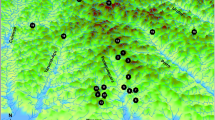Abstract
We revealed the range and current status of genetic disturbances in wild medaka populations (Oryzias latipes species complex) using two DNA markers (cytb gene and b-marker). Genetic disturbances were detected in many wild populations throughout Japan and were primarily caused by artificial introduction of the commercial medaka variety, himedaka. We identified native medaka populations without introgressions, which may be significant conservation targets. To conserve the native genetic diversity of the medaka species complex, further introduction of himedaka should be prevented by educating the public about the current status and risks of introducing non-native medaka varieties into the wild.

Similar content being viewed by others
References
Aida T (1921) On the inheritance of a color in a fresh water fish, Aplocheilus latipes Temmink and Schlegel, with special reference to sex-linked inheritance. Genetics 6:554–573
Allendorf FW, Luikart G, Aitken SN (2013) Conservation and the genetics of populations. Wiley-Blackwell Publication, Hoboken
Asahida T, Kobayashi T, Saitoh K, Nakayama T (1996) Tissue preservation and total DNA extraction from fish stored at ambient temperature using buffers containing high concentration of urea. Fish Sci 62:727–730
Asai T, Senou H, Hosoya K (2011) Oryzias sakaizumii, a new ricefish from northern Japan (Teleostei: Adrianichthydae). Ichthyol Explor Freshw 22:289–299
Frankham R, Ballow JD, Briscoe DA (2002) Introduction to conservation genetics. Cambridge University Press, Cambridge
Fukamachi S, Shimada A, Shima A (2001) Mutations in the gene encoding B, a novel transporter protein, reduce melanin content in medaka. Nat Genet 28:381–385
Fukamachi S, Kinoshita M, Tsujimura T, Shimada A, Oda S, Shima A, Meyer A, Kawamura S, Mitani H (2008) Rescue from oculocutaneous albinism Type 4 using medaka slc45a2 cDNA driven by its own promoter. Genetics 178:761–769
Kitagawa T (2013) Genetic disturbance caused by Himedaka in Yamato river system. In: Nature Conservation Committee of Ichthyological Society of Japan (ed) Domestic alien fishes: Hidden threats to biodiversity. Tokai University Press, Hadano, pp 101–117
Koyama N, Kitagawa T (2009) Mitochondrial DNA originating from the orange-red type commercial varieties of Oryzias latipes (himedaka) detected in wild populations inhabiting the Yamato River System, Nara Prefecture. Jpn J Ichthyol 56:153–157
Koyama N, Mori T, Nakai K, Kitagawa T (2011) Genetic composition of commercial strains of Oryzias latipes revealed by mtDNA analysis. Jpn J Icthyol 58:81–86
Ministry of Education, Culture, Sports, Science and Technology Japan (2008) 5th grade. In: Takahashi M, Ushio N, HHioki M, Kamiyama H, Sakashita Y (eds) School curriculum guideline of Science in elementary school, Tokyo, pp 51–63
Ministry of Environment Japan (2015) Red Data Book 2014 -Threatened Wildlife of Japan. Gyosei Corporation, Tokyo
Nakai K, Nakao R, Fukamachi S, Koyama N, Kitagawa T (2011) Genetic analysis of Medaka (Oryzias latipes) populations in the Yamato River, Nara prefecture, Japan: detection of the b allele responsible for the himedaka phenotype. Jpn J Ichthyol 58:189–193
Sakaizumi M (1990) Intraspecific variation of Japanese medaka from genetic analyses. In: Egami N, Yamagami K, Shima A (eds) Biology of medaka. Tokyo University Press, Tokyo, pp 143–161
Takehana Y, Nagai N, Matsuda M, Tsuchiya K, Sakaizumi M (2003) Geographic variation and diversity of the cytochrome b gene in Japanese wild populations of medaka, Oryzias latipes. Zool Sci 20:1279–1291
Yokota H, Kuwahara N, Nakano E, Eguchi S (2014) Genotype distribution in wild populations medaka inhabiting the Muko river system and the actual state of genetic introgression from the demonstrated orange-red fish (hi-medaka). Bull Kansai Org Nat Cons 36:53–58
Acknowledgments
We thank M. Kobayashi (ICU), Y. Kano (DSKU), M. Fukui (KESC), T. Hagiwara (GEF), and many others for helping with specimen collection. We are grateful to K. Hosoya, Y. Kubo, and other members of the Aquatic Ecology Laboratory of KUN for their useful advice and help with specimen sampling and fieldwork. This study was partially funded by a research grant from the Kinki University in 2010 (Subject number: SR14). This study complies with the current laws of Japan.
Author information
Authors and Affiliations
Corresponding author
Electronic supplementary material
Below is the link to the electronic supplementary material.
About this article
Cite this article
Nakao, R., Iguchi, Y., Koyama, N. et al. Current status of genetic disturbances in wild medaka populations (Oryzias latipes species complex) in Japan. Ichthyol Res 64, 116–119 (2017). https://doi.org/10.1007/s10228-016-0528-5
Received:
Revised:
Accepted:
Published:
Issue Date:
DOI: https://doi.org/10.1007/s10228-016-0528-5




